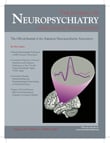Digoxin-Like Immunoreactive Factor in Human Cerebrospinal Fluid
SIR: Mammals produce a family of endogenous compounds that resemble the sodium pump-inhibiting cardiac glycosides, digoxin and ouabain. 1 These endogenous cardenolides have been proposed to be important in the pathophysiology of bipolar illness, where it is relatively deficient in the serum of manic subjects. 1 The measurement of these compounds in the CNS has not been previously documented.
Refrigerated cerebrospinal fluid (CSF) waste was frozen at −70°C within 18 hours of collection. Digoxin-like immunoreactive factor (DLIF) was measured by radioimmunoassay as described by Grider et al., 1 using components provided by New England Nuclear (Billerica, Mass.). The correlation among four samples quantified twice was 0.88.
Ten samples were studied from three women and seven men. Mean age among the women was 41.9 years (range=30 to 53), and among the men it was 61.6 years (range=32 to 94). Mean DLIF concentration was 91.7 pg digoxin equivalents/ml.
Comment
Human CSF contains a substance which cross reacts with antidigoxin antibodies. This supports previous reports of CSF factors that bear immunologic resemblance to cardiac glycosides 2 and sodium pump inhibitory activity of CSF. 3 Though the source of CSF DLIF is not known, similar compounds have been purified from mammalian hypothalamus. 4 Given that the hypothalamic-pituitary-adrenal axis may be dysregulated in bipolar illness, that DLIF production is responsive to dexamethasone and adreno-corticotropin hormone (ACTH), 5 and that DLIF may be dysregulated in bipolar subjects, 1 it would seem important to study CSF DLIF in bipolar illness.
1. Grider G, El-Mallakh RS, Huff MO, et al: Endogenous digoxin-like immunoreactive factor (DLIF) serum concentrations are decreased in manic bipolar patients compared to normal controls. J Affect Disord 1999; 54:261–267Google Scholar
2. Halprin JA, Riordan JF, Tosteson DC: Characterization of an inhibitor of the Na + /K + pump in human cerebrospinal fluid. J Biol Chem 1988; 263:646–651 Google Scholar
3. Hamlyn JM, Blaustein MP, Bova S, et al: Identification and characterization of a ouabain-like compound from human plasma. Proc Natl Acad Sci USA: 1991; 88:6259–6263Google Scholar
4. Lichtstein D, Minc D, Bourrit A, et al: Evidence for the presence of “ouabain-like” compound in human cerebrospinal fluid. Brain Res 1985; 325:13–19Google Scholar
5. Shilo L, Dolev S, Shapiro MS, et al: Endogenous digoxin-like material is of adrenal origin. Israel J Med Sci 1987; 23:294–295Google Scholar



